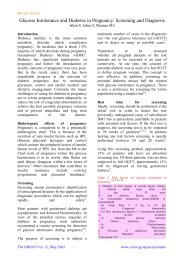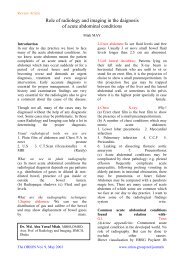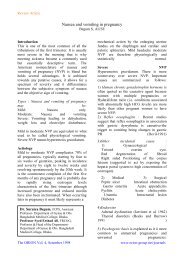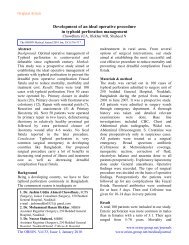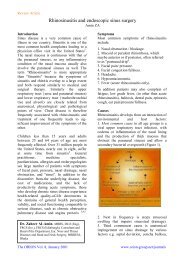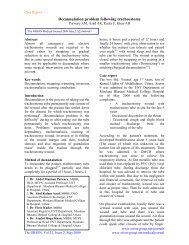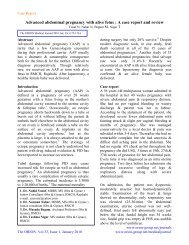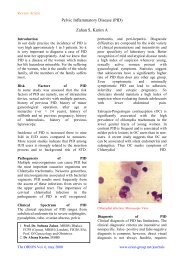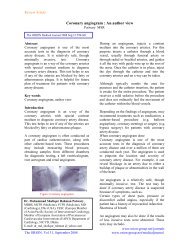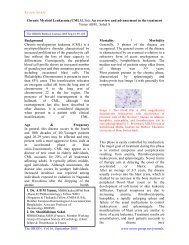Rheumatic disorders & bone problems in diabetes ... - Orion Group
Rheumatic disorders & bone problems in diabetes ... - Orion Group
Rheumatic disorders & bone problems in diabetes ... - Orion Group
Create successful ePaper yourself
Turn your PDF publications into a flip-book with our unique Google optimized e-Paper software.
Review Article<br />
<strong>Rheumatic</strong> <strong>disorders</strong> & <strong>bone</strong> <strong>problems</strong> <strong>in</strong> <strong>diabetes</strong> mellitus<br />
Musa AKM, Nazimudd<strong>in</strong> K, Huq SA, Sarker RSC, Ahmed AKMS<br />
The ORION Medical Journal 2006 Jan; 23:344-346<br />
Introduction<br />
A variety of conditions may affect the<br />
locomotor system <strong>in</strong> diabetic subjects caus<strong>in</strong>g<br />
several <strong>Rheumatic</strong> <strong>problems</strong> and bony lesions.<br />
The limited jo<strong>in</strong>t mobility (cheiroarthropathy)<br />
is characterized by stiffness of the small jo<strong>in</strong>ts<br />
of the hands and other sites. A variety of soft<br />
tissue <strong>Rheumatic</strong> conditions are seen <strong>in</strong><br />
<strong>diabetes</strong> such as Adhesive Capsulitis of the<br />
shoulder, flexor tenosynovitis and Carpal<br />
tunnel syndrome. Hyperostotic <strong>bone</strong> change,<br />
Diffuse Idiopathic Skeletal Hyperostosis<br />
(DISH) develops early <strong>in</strong> <strong>diabetes</strong> particularly<br />
<strong>in</strong> type 2 Diabetes. Diabetic osteoarthropathy<br />
(Charcot's jo<strong>in</strong>t) is characterized by destruction<br />
and lytic <strong>bone</strong> changes affect<strong>in</strong>g the <strong>bone</strong>s of<br />
the foot. Gout and Pseudogout are also seen<br />
more frequently <strong>in</strong> Diabetes 1,2 .<br />
Limited jo<strong>in</strong>t mobility (diabetic<br />
cheiroarthropathy)<br />
In Diabetes of long duration there is thicken<strong>in</strong>g<br />
and tighten<strong>in</strong>g of the sk<strong>in</strong> particularly of the<br />
dorsum of hands giv<strong>in</strong>g the resemblance to the<br />
waxy tight sk<strong>in</strong> seen <strong>in</strong> patients with Systemic<br />
Sclerosis<br />
(Scleroderma).<br />
Pathogenesis<br />
Multifactorial : Microangiopathy leads to<br />
connective tissue ischaemia with resultant<br />
fibrosis.<br />
1.Dr. A. K. M. Musa, FCPS (Medic<strong>in</strong>e), MCPS<br />
(Medic<strong>in</strong>e), DTCD, Assistant Professor, BIRDEM<br />
(Medic<strong>in</strong>e unit -I) and Ibrahim Medical College<br />
2.Dr. Khwaja Nazimudd<strong>in</strong>, FCPS (Medic<strong>in</strong>e),<br />
Assoc. Professor, BIRDEM (Medic<strong>in</strong>e unit -I) and<br />
Ibrahim Medical College<br />
3.Dr. Sadia Afr<strong>in</strong> Huq, MBBS, Honorary<br />
Medical Officer, Medic<strong>in</strong>e unit-I, BIRDEM<br />
Hospital,<br />
Dhaka<br />
4.Dr. Rene Suzan Claude Sarker, MBBS,<br />
Assistant Registrar, Medic<strong>in</strong>e unit-I, BIRDEM<br />
Hospital,<br />
Dhaka<br />
5.A. K. M. Shaheen Ahmed, FCPS (medic<strong>in</strong>e),<br />
MCPS (Medic<strong>in</strong>e), Registrar, BIRDEM (Medic<strong>in</strong>e<br />
unit -I) and Ibrahim Medical College<br />
The ORION. Vol 23, January 2006<br />
Symptoms : Stiffness of f<strong>in</strong>ger & restriction <strong>in</strong><br />
normal activity such as<br />
-Us<strong>in</strong>g <strong>in</strong>sul<strong>in</strong> syr<strong>in</strong>ge.<br />
-Difficulty <strong>in</strong> form<strong>in</strong>g a fist.<br />
-Reduction <strong>in</strong> grip strength<br />
-Problem <strong>in</strong> f<strong>in</strong>e movement.<br />
On<br />
Exam<strong>in</strong>ation<br />
Prayer sign positive<br />
Patient may not be able to closely appose some<br />
www.orion-group.net/journals<br />
www.orion-group.net/medicaljournal
Review Article<br />
Treatment : Spl<strong>in</strong>ts, NSAIDS, Diuretics, local<br />
or all f<strong>in</strong>gers when palms are placed together.<br />
confirmation 1, 2, 5 characterized by pa<strong>in</strong> and<br />
steroid <strong>in</strong>jection <strong>in</strong>to the Carpal tunnels,<br />
In differentiat<strong>in</strong>g with scleroderma<br />
surgical decompression.<br />
-Raynaud's Phenomenon is absent (positive <strong>in</strong><br />
90% cases of scleroderma).<br />
-ESR or CRP is not raised.<br />
-Topoisomerase & centromere activity is not<br />
present.<br />
-Radiologically- no pulp atrophy.<br />
Management<br />
-Strict glycaemic control.<br />
-Physiotherapy.<br />
Dupuytren's<br />
contracture<br />
Occurs <strong>in</strong> 33%-60% of patients with IDDM.<br />
Patients present with nodular thicken<strong>in</strong>g of the Adhesive capsulitis/frozen shoulder<br />
palmar fascia lead<strong>in</strong>g to flexor contracture It occurs <strong>in</strong> 10% -33% of Diabetics and is more<br />
1, 2, 3.<br />
usually of the fourth and fifth digits common <strong>in</strong> Diabetics than <strong>in</strong> non-Diabetics.<br />
The typical patient is female with NIDDM of<br />
Flexor tenosynovitis<br />
long duration who present with diffuse soreness<br />
Occurs <strong>in</strong> 5%-33% of diabetic patients. and global loss of motion of shoulder. Up to<br />
Females with long stand<strong>in</strong>g Diabetes are more 50% of patients have bilateral <strong>in</strong>volvements.<br />
commonly affected than males. Patients Laboratory studies and radiographs are<br />
5, 6, 7, 8.<br />
compla<strong>in</strong> of ach<strong>in</strong>g and stiffness <strong>in</strong> the palmar unremarkable<br />
aspect of the hands. A trigger f<strong>in</strong>ger may occur<br />
as a result of an <strong>in</strong>flammatory nodule gett<strong>in</strong>g Treatment: Treatment <strong>in</strong>cludes NSAIDS, rarely<br />
caught <strong>in</strong> the proximal pulley at the base of the <strong>in</strong>tra-articular steroids and vigorous physical<br />
f<strong>in</strong>ger. The thumb of the dom<strong>in</strong>ant hand is most therapy to improve range of motion.<br />
commonly <strong>in</strong>volved (75%). Laboratory f<strong>in</strong>d<strong>in</strong>gs<br />
and radiographs are unremarkable.Treatment<br />
<strong>in</strong>cludes NSAIDS, local steroid <strong>in</strong>jection &<br />
surgery<br />
1,2,3,4.<br />
Treatment <strong>in</strong>cludes: NSAIDs, Physical<br />
theraphy, Vit-E, Local corticosteroid <strong>in</strong>jection<br />
& rarely surgery.<br />
Carpal tunnel syndrome (CTS)<br />
CTS commonly occurs <strong>in</strong> diabetic patients. Up<br />
to 15% of all patients with CTS will have<br />
<strong>diabetes</strong>. Patient presents with numbness <strong>in</strong> the<br />
Median nerve distribution, nocturnal Shoulder hand syndrome<br />
paresthesia, hand pa<strong>in</strong> and pa<strong>in</strong> radiat<strong>in</strong>g to the<br />
arm and shoulder. T<strong>in</strong>els and Phalens signs<br />
Also known as Reflex Sympathetic Dystrophy<br />
Syndrome and is referred to as Complex<br />
may be positive. NCV can be done for Regional Pa<strong>in</strong> Syndrome Type-1. It is<br />
The ORION. Vol 23, January 2006<br />
www.orion-group.net/journals<br />
www.orion-group.net/medicaljournal
Review Article<br />
swell<strong>in</strong>g usually <strong>in</strong> the distal extrimity<br />
accompanied by vasomotor <strong>in</strong>stability, trophic<br />
sk<strong>in</strong> changes and rapid development of bony<br />
dem<strong>in</strong>eralization 8,9.<br />
Neuropathic jo<strong>in</strong>t (charcot's jo<strong>in</strong>t)<br />
Progressive destructive arthritis associated with<br />
loss of pa<strong>in</strong>, proprioception or both. First<br />
described by Jean Marf<strong>in</strong> Charcot <strong>in</strong> 1968 <strong>in</strong><br />
patients with Tabes dorsalis. Charcot's jo<strong>in</strong>t<br />
occurs <strong>in</strong> 66% ) are over age 40 and have had long<br />
stand<strong>in</strong>g >10 yrs poorly controlled Diabetes<br />
mellitus complicated by a diabetic peripheral<br />
neuropathy 1,9.<br />
Destruction, Density (<strong>in</strong>creased), Debris,<br />
Disorganization, and Dislocation. The<br />
<strong>in</strong>creased density and sharp marg<strong>in</strong> of the bony<br />
debris help <strong>in</strong> separat<strong>in</strong>g a Charcot's jo<strong>in</strong>t from<br />
<strong>in</strong>fection.<br />
Isotope <strong>bone</strong> scan us<strong>in</strong>g Indian 111- labeled<br />
WBC is helpful <strong>in</strong> differentiat<strong>in</strong>g from<br />
Osteomyelitis (Test positive cases). Sometimes<br />
CT scan or MRI scan may be required.<br />
Treatment<br />
•Immobilization.<br />
•Bisphosphonates to reduce osteoclastic<br />
activity<br />
•Reconstructive orthopedic techniques.<br />
In Diabetics early recognition and treatment of<br />
a Charcot's foot by prohibit<strong>in</strong>g weight bear<strong>in</strong>g<br />
for at least 8 weeks may lower the chance of<br />
severe<br />
1,<br />
disease<br />
2, 7, 9, 10.<br />
Osteoarthrosis<br />
Diabetic subjects are more likely to be <strong>in</strong>volved<br />
with degenerative arthritis earlier and <strong>in</strong> the<br />
more severe form. Osteoarthrosis may be l<strong>in</strong>ked<br />
with obesity <strong>in</strong> Diabetes 1 .<br />
Pathogenesis : Increased blood flow through<br />
the foot, secondary to local autonomic<br />
denervation, together with abnormal pressure<br />
load<strong>in</strong>g may lead to unsuspected fracture with<br />
m<strong>in</strong>imal normal daily trauma.<br />
Symptomatology : The usual presentation is<br />
swell<strong>in</strong>g of the foot with no or little pa<strong>in</strong> with<br />
progression of disease. The patient can develop<br />
"Rocker bottom" feet due to metatarsal<br />
collapse.<br />
Diagnosis : Radiographs frequently show<br />
severe abnormalities characterized by the 5D's-<br />
The ORION. Vol 23, January 2006<br />
Gout & hyperuricaemia<br />
An <strong>in</strong>crease <strong>in</strong> serum uric acid concentration is<br />
a marker for CHD and is associated with<br />
glucose <strong>in</strong>tolerance. Hyperuricaemia is also<br />
more prevalent among <strong>in</strong>dividuals with obesity,<br />
hyperlipidaemia and hypertension and so has<br />
been considered by some <strong>in</strong>vestigators to be<br />
part of Insul<strong>in</strong> Resistance Syndrome 7 .<br />
Pseudogout<br />
Calcium pyrophosphate deposition arthropathy<br />
is characteristically seen <strong>in</strong> older subjects and<br />
www.orion-group.net/journals<br />
www.orion-group.net/medicaljournal
Review Article<br />
usually affects the larger jo<strong>in</strong>ts such as the<br />
knees. Radiography shows features of<br />
1, 7.<br />
chondrocalc<strong>in</strong>osis<br />
Bone <strong>problems</strong> <strong>in</strong> <strong>diabetes</strong> mellitus<br />
Diffuse ldiopathic skeletal hyperostosis (DISH;<br />
Forestier's disease) is a non <strong>in</strong>flammatory<br />
disease occur<strong>in</strong>g <strong>in</strong> male aged over 50 years. It<br />
is characterized by flow<strong>in</strong>g hyperostosis (Bone<br />
formation), calcification of the anterior<br />
longitud<strong>in</strong>al ligament of at least 4 contiguous<br />
vertebral bodies and non erosive enthesopathies<br />
(Whisker<strong>in</strong>g). The disease is not associated<br />
with sacroilitis, apophyseal ankylosis or HLA<br />
B-27. Patients are frequently are asymptomatic.<br />
DISH occurs <strong>in</strong> upto half of diabetic patients<br />
compared to nearly 13% <strong>in</strong> the general<br />
population 1, 8, 12 .<br />
Treatment is with NSAIDS if there is pa<strong>in</strong>,<br />
exercise to reta<strong>in</strong> movement and muscle<br />
strength. Osteopenia & fracture particularly<br />
with type I <strong>diabetes</strong> of long duration may occur<br />
due to reduced <strong>bone</strong> m<strong>in</strong>eral density compared<br />
to non-diabetic population 1,8 .<br />
Conclusion<br />
It has been clear that a good number of<br />
musculoskeletal <strong>disorders</strong> are associated with<br />
Diabetes mellitus. These <strong>disorders</strong> not only<br />
<strong>in</strong>crease the disability of patients but some of<br />
the musculoskeletal syndrome has def<strong>in</strong>ite<br />
correlation with other diabetic complications<br />
for example LJM and ret<strong>in</strong>opathy has been well<br />
established. F<strong>in</strong>ally Diabetes must be<br />
considered <strong>in</strong> the differential diagnosis of<br />
Musculoskeletal Syndromes when other signs<br />
and symptoms suggestive of Diabetes is present<br />
1,2,10 .<br />
References<br />
1. Badal Pal. <strong>Rheumatic</strong> disorder and <strong>bone</strong><br />
problem <strong>in</strong> Diabetes mellitus <strong>in</strong> Text Book of<br />
Diabetes. John C. Pickup (3rd Edition); 2003:<br />
61.1 - 61.12<br />
2. Raman PG; Jo<strong>in</strong>t and <strong>bone</strong> manifestation of<br />
Diabetes Mellitus <strong>in</strong> Diabetes Mellitus 2nd<br />
Edition; 2000: 149-54.<br />
3. Susan F. Krupp , Lee S. Simon. Jo<strong>in</strong>t and<br />
<strong>bone</strong> manifestations of Diabetes mellitus. Josl<strong>in</strong><br />
Diabetes; 1996: 912 - 921.<br />
4. Adrian J. Crisp. Connective tissue and jo<strong>in</strong>t<br />
disease <strong>in</strong> Diabetes mellitus, Text Book of<br />
Diabetes; 770 -792.<br />
5. M. Barry, JR. Jenner. ABC of Rheumatology<br />
BMJ; March 1995: Vol. 11: 64 -68.<br />
6. Micheal Shipley. ABC of Rheumatology;<br />
April 1995: Vol 11, 175 -179.<br />
7. Andrew J. Krentz. Churchill's pocket book of<br />
Diabetes. 218 - 219; 258<br />
8. Edmund H. Hornsten. Endocr<strong>in</strong>e associated<br />
arthropathies, Rheumatology Secrets 2nd<br />
Edition: 343 - 346.<br />
9. Gillilana BC. Fibromyalgia. Arthritis<br />
associated with systemic disease <strong>in</strong> Harrison's<br />
Pr<strong>in</strong>ciple of Internal Medic<strong>in</strong>e, 16th Edition:<br />
2055-2064.<br />
10. Alan Hakim. Oxford Handbook of<br />
Rheumatology: 234 -235.<br />
11. Helen E turner & John AH Wass. Oxford<br />
Handbook of Endocr<strong>in</strong>ology & <strong>diabetes</strong>: 872-<br />
878.<br />
12. Dohery M, Laryon P. Musculoskeletal<br />
Disorder <strong>in</strong> Davidson's Pr<strong>in</strong>ciples and Practice<br />
of Medic<strong>in</strong>e.19th Edition; 2002. 984<br />
The ORION. Vol 23, January 2006<br />
www.orion-group.net/journals<br />
www.orion-group.net/medicaljournal



